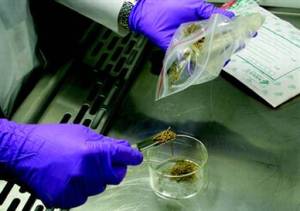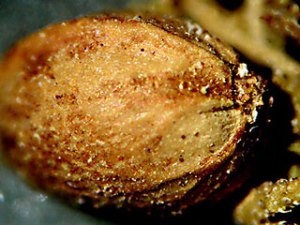

Nearly two pounds of still-green marijuana has been found in the grave of a man who was buried 2,700 years ago. It is the oldest known stash of pot ever discovered. Found in the Yanghai Tombs near Turpan, Xinjiang-Uighur Autonomous Region, China, a sample was subjected to a battery of tests conducted by an 18-member research team. The results are published in the Journal of Experimental Botany.
To get really technical (skip this part if you want):
A large cache of cannabis, superbly preserved by climatic and burial conditions was tested by a multidisciplinary international team who demonstrated through botanical examination, phytochemical investigation, and genetic deoxyribonucleic acid analysis by polymerase chain reaction that this material contained tetrahydrocannabinol, the psychoactive component of cannabis, its oxidative degradation product, cannabinol, other metabolites, and its synthetic enzyme, tetrahydrocannabinolic acid synthase, as well as a novel genetic variant with two single nucleotide polymorphisms. The cannabis was presumably employed by this culture as a medicinal or psychoactive agent, or an aid to divination. To our knowledge, these investigations provide the oldest documentation of cannabis as a pharmacologically active agent, and contribute to the medical and archaeological record of this pre-Silk Road culture.
The plain English translation:
The extremely dry conditions and alkaline soil acted as preservatives, allowing a team of scientists to carefully analyze the stash, which still looked green though it had lost its distinctive odor. A barrage of tests proves the marijuana possessed potent psychoactive properties (a relatively high content of THC, the main active ingredient in cannabis). However, no one could feel its effects today, due to decomposition over the millennia. The scientists are unsure if the marijuana was grown for spiritual or medical purposes.
“To our knowledge, these investigations provide the oldest documentation of cannabis as a pharmacologically active agent,” says the newly published paper, whose lead author was American neurologist Dr. Ethan B. Russo.
The researchers couldn’t tell if the weed was meant to be smoked or eaten. No pipes or other clues were found in the tomb. The large cache was contained in a leather basket and in a wooden bowl, and was likely meant to be used in the afterlife.
The 789 grams of dried cannabis was buried alongside a light-haired, blue-eyed Caucasian man – who died around the age of 45 – likely a shaman of the Gushi culture, near Turpan in northwestern China. The tomb also contained other items confirming the man’s high social standing.
“This individual was buried with an unusual number of high value, rare items,” Russo said, mentioning that the objects included a make-up bag, bridles, pots, archery equipment and a kongou harp. The researchers believe the individual was a shaman from the Gushi people, who spoke a now-extinct language called Tocharian that was similar to Celtic.
The size of seeds mixed in with the leaves, along with their color and other characteristics, indicate the marijuana came from a cultivated strain. Before the burial, someone had carefully picked out all of the male plant parts, which are less psychoactive, leaving little doubt as to why the cannabis was grown. Scientists also tried to germinate 100 of the seeds found in the cache, without success.
The region of China where the tomb is located, Xinjiang, is considered an original source of many cannabis strains worldwide. The ancient marijuana stash is now housed at Turpan Museum in China.












